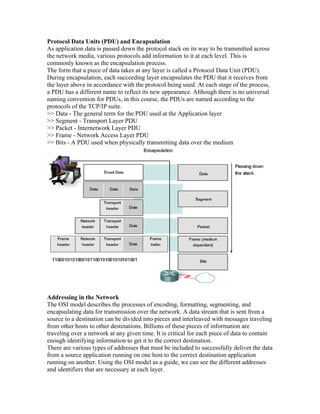
Ch1 computer networks internet_encapsulation_4
- 1. Protocol Data Units (PDU) and Encapsulation As application data is passed down the protocol stack on its way to be transmitted across the network media, various protocols add information to it at each level. This is commonly known as the encapsulation process. The form that a piece of data takes at any layer is called a Protocol Data Unit (PDU). During encapsulation, each succeeding layer encapsulates the PDU that it receives from the layer above in accordance with the protocol being used. At each stage of the process, a PDU has a different name to reflect its new appearance. Although there is no universal naming convention for PDUs, in this course, the PDUs are named according to the protocols of the TCP/IP suite. >> Data - The general term for the PDU used at the Application layer >> Segment - Transport Layer PDU >> Packet - Internetwork Layer PDU >> Frame - Network Access Layer PDU >> Bits - A PDU used when physically transmitting data over the medium Addressing in the Network The OSI model describes the processes of encoding, formatting, segmenting, and encapsulating data for transmission over the network. A data stream that is sent from a source to a destination can be divided into pieces and interleaved with messages traveling from other hosts to other destinations. Billions of these pieces of information are traveling over a network at any given time. It is critical for each piece of data to contain enough identifying information to get it to the correct destination. There are various types of addresses that must be included to successfully deliver the data from a source application running on one host to the correct destination application running on another. Using the OSI model as a guide, we can see the different addresses and identifiers that are necessary at each layer.
- 2. Getting the Data to the End Device During the process of encapsulation, address identifiers are added to the data as it travels down the protocol stack on the source host. Just as there are multiple layers of protocols that prepare the data for transmission to its destination, there are multiple layers of addressing to ensure its delivery. The first identifier, the host physical address, is contained in the header of the Layer 2 PDU, called a frame. Layer 2 is concerned with the delivery of messages on a single local network. The Layer 2 address is unique on the local network and represents the address of the end device on the physical media. In a LAN using Ethernet, this address is called the Media Access Control (MAC) address. When two end devices communicate on the local Ethernet network, the frames that are exchanged between them contain the destination and source MAC addresses. Once a frame is successfully received by the destination host, the Layer 2 address information is removed as the data is decapsulated and moved up the protocol stack to Layer 3. Getting the Data through the Internetwork Layer 3 protocols are primarily designed to move data from one local network to another local network within an internetwork. Whereas Layer 2 addresses are only used to communicate between devices on a single local network, Layer 3 addresses must include identifiers that enable intermediary network devices to locate hosts on different networks. In the TCP/IP protocol suite, every IP host address contains information about the network where the host is located.
- 3. At the boundary of each local network, an intermediary network device, usually a router, decapsulates the frame to read the destination host address contained in the header of the packet, the Layer 3 PDU. Routers use the network identifier portion of this address to determine which path to use to reach the destination host. Once the path is determined, the router encapsulates the packet in a new frame and sends it on its way toward the destination end device. When the frame reaches its final destination, the frame and packet headers are removed and the data moved up to Layer 4. Getting the Data to the Right Application At Layer 4, information contained in the PDU header does not identify a destination host or a destination network. What it does identify is the specific process or service running on the destination host device that will act on the data being delivered. Hosts, whether they are clients or servers on the Internet, can run multiple network applications simultaneously. People using PCs often have an e-mail client running at the same time as a web browser, an instant messaging program, some streaming media, and perhaps even a game. All these separately running programs are examples of individual processes. Viewing a web page invokes at least one network process. Clicking a hyperlink causes a web browser to communicate with a web server. At the same time, in the background, an e-mail client may be sending and receiving email, and a colleague or friend may be sending an instant message. Think about a computer that has only one network interface on it. All the data streams created by the applications that are running on the PC enter and leave through that one interface, yet instant messages do not popup in the middle of word processor document or e-mail showing up in a game. This is because the individual processes running on the source and destination hosts communicate with each other. Each application or service is represented at Layer 4 by a port number. A unique dialogue between devices is identified with a pair of Layer 4 source and destination port numbers that are representative of the two communicating applications. When the data is received at the host, the port number is examined to determine which application or process is the correct destination for the data.
